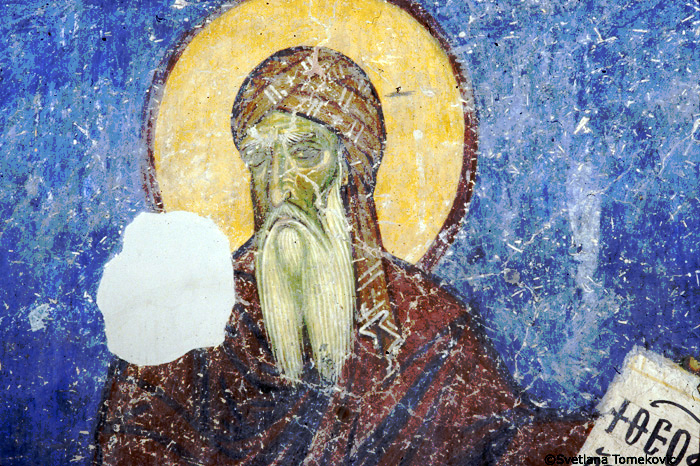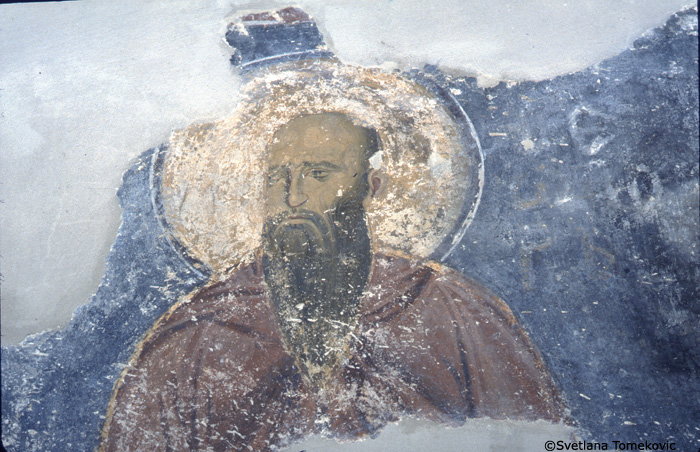Fresco at Studenica, Serbia, with Saint Theodorus Graptos, monk
Saints Théodore et Théophane
Martyrs de l'iconoclasme (9ème s.)
Ils appartenaient au monastère de Chora à Constantinople. Victimes de la querelle iconoclaste, ils furent d'abord enfermés dans une des forteresses du Bosphore. A quelque temps de là, on grava sur leur front, aux fers rouges, des vers satiriques. Déportés en Bithynie, Théodore y mourut en 842. Théophane put retourner à Constantinople une fois la paix religieuse revenue.
Commémoraison des saints frères Théodore et Théophane. Élevés dès leur enfance au monastère palestinien de Saint-Sabas, ils luttèrent courageusement à Constantinople en faveur du culte des saintes images et subirent à plusieurs reprises les coups de fouet, la prison, l’exil et même un tatouage sur le front qui leur valut le surnom de Graptoi (Tatoués). Théodore mourut en prison en ce jour à Apamée en Bithynie vers 840. Quant à Théophane, quand la paix fut rendue à l’Église, il devint évêque de Nicée et s’endormit dans le Seigneur le 11 octobre 845.
Martyrologe romain
SOURCE : http://nominis.cef.fr/contenus/saint/322/Saints-Theodore-et-Theophane.html
Saint Théophane l'Hymnographe
Évêque de Nicée (9ème s.)
Jeune frère de Saint Théodore, il appartenait au monastère de Saint Sabas en Palestine et connut simultanément la lutte contre le culte des icônes de l'empereur Léon l'Arménien et l'invasion arabe.
Il eut à subir l'exil pour la foi orthodoxe après avoir été marqué au fer rouge sur le front. Lorsque la vénération des icônes fut à nouveau autorisée, il put rentrer et devenir évêque de Nicée.
Il passa en paix les dernières années de sa vie composant une quantité considérable de canons poétiques. Beaucoup d'entre eux sont encore chantés de nos jours pour les fêtes du Seigneur.
Saint Théophane l’hymnographe, il composait aussi pour Marie
Isabelle
Cousturié - Publié le 10/10/18
Saint Théophane l’hymnographe, fêté ce 11 octobre, a
composé une quantité considérable de canons poétiques, encore en usage
aujourd’hui, dont une hymne à la Vierge Marie célébrant son Assomption.
Jeune frère de saint Théodore, Théophane appartenait au monastère de Saint-Sabas
en Palestine. Moine et confesseurs de la foi orthodoxe, il eut à souffrir avec
son frère des persécutions de l’empereur Léon l’Arménien et de l’invasion
arabe. Comme lui, le front marqué au fer rouge indiquant la cause de leur
condamnation — d’où son leur surnom « Graptoi » (marqués) — il subit
l’exil à Apamée en Bithynie, mais où ils feront l’admiration de tous par leur
orthodoxie, leur ascèse et la perfection de leur charité. À la mort de son
frère, épuisé par les mauvais traitements subis, Théophane est exilé à
Thessalonique d’où il reviendra et sera nommé évêque de Nicée en 842.
Un bel héritage
Théophane passa en paix les dernières années de sa
vie, composant une quantité considérable d’hymnes sacrées. Beaucoup d’entre eux
sont encore chantés de nos jours pour les fêtes du Seigneur. Le saint évêque
figure parmi les principaux poètes religieux du IXe siècle byzantin. 181
de ses poèmes liturgiques font la fierté de l’Église. Comme cette magnifique
hymne sacrée à l’Assomption de Marie, qui est appelée Dormition dans la
tradition orientale, où saint Théophane célèbre très clairement l’entrée
directe de la Vierge Marie, Mère de Dieu, dans la gloire de Dieu, invitant les
fidèles à participer à ce qui n’était encore qu’une fête (largement répandue)
avant d’être un dogme, déjà célébrée le 15 août
« Votre tombeau, O Immaculée proclame votre
sépulcre et votre migration aux cieux avec votre corps. Venez, fidèles pieux à
cette fête ; venez, organisons un chœur ; venez enguirlandons l’église de nos
cantiques à l’occasion du repos de Celle qui est l’Arche de Dieu. C’est
aujourd’hui, en effet, que le ciel déploie son sein pour recevoir celle qui a
donné le jour à Celui que l’univers ne peut contenir. Et la terre, restituant
la Source de la vie, se revêt de bénédiction et de magnificence. Les anges
s’assemblent en chœur avec les apôtres et regardent avec un saint tremblement
passer de la vie à la vie Celle qui a enfanter l’Auteur de la vie.
Prosternons-nous en prière devant elle. N’oubliez pas, o notre Souveraine,
l’étroite parenté qui vous lie à ceux qui célèbrent votre toute sainte
dormition ».
SOURCE : https://fr.aleteia.org/2018/10/10/saint-theophane-lhymnographe-il-composait-aussi-pour-marie/
Saint Théophane naquit en 778 en Palestine, de parents pieux qui excellaient dans la vertu de l'hospitalité. Ceux-ci enseignèrent à leurs fils tous ce qu'ils savaient de la science sacrée et de la sagesse profane. Puis ils les envoyèrent au Monastère de Saint-Sabas, pour y parfaire leurs connaissances et surtout pour y être initiés à la Science des sciences et à l'Art des arts: la vie monastique. Théophane suivait en toutes choses l'exemple de son aimé, Théodore, et ne brillait pas moins que lui dans l'humilité et l'obéissance, comme dans le savoir et le don pour la composition des hymnes sacrées. Ils furent tous deux ordonnés Prêtres et s'appliquaient à croître chaque jour dans l'amour de Dieu, lorsque Léon l'Arménien (813-820) déclencha une nouvelle vague de persécutions contre ceux qui vénéraient les Saintes Images. Ses premières mesures furent dirigées contre les Evêques Orthodoxes, puis il ordonna de supprimer toutes les icônes et d'effacer toutes les fresques dans les églises. Cette impiété attira la colère de Dieu, qui permit alors aux armées arabes d'envahir une grande partie du territoire de l'empire, dont la Palestine et le Monastère de Saint-Sabas. Discernant la main de Dieu à la vue de ces désastres, le Patriarche Thomas de Jérusalem décida d'envoyer en ambassade, d'abord à Rome puis à Constantinople, les deux frères Théodore et Théophane avec leur père spirituel, Michel le Syncelle (mémoire le 18 décembre), pour essayer de convaincre l'empereur de son erreur. Léon admira leur courage et leur sagesse et essaya de les attirer à son parti; mais, voyant qu'il ne pourrait pas y parvenir, il fit soumettre les deux frères à la torture et les envoya en exil, interdisant à quiconque sous peine de mort de leur venir en aide, même pour les choses les plus nécessaires. Grâce à Dieu, les Saints n'endurèrent pas longtemps cet exil, car Léon fut bientôt assassiné et remplacé par Michel II (820-829). Pendant le règne de ce dernier les persécutions contre les Orthodoxes marquèrent une accalmie, mais l'on en restaura pas pour autant officiellement le culte des Saintes Icônes; et lorsque son fils Théophile (829-842) prit la succession, les persécutions reprirent avec une ampleur et une férocité encore inégalées. Saints Théodore et Théophane furent à nouveau torturés et souffrirent pour l'amour de la Foi Orthodoxe la faim, la soif, les moqueries, les coups, les prisons et l'exil. L'empereur, qui connaissait leur indomptable courage, les fit comparaître et torturer en sa présence pendant quatre jours, puis il leur fit marquer sur le front au fer rouge douze vers iambiques, indiquant la cause de leur condamnation2. Ils furent ensuite exilés à Apamée en Bithynie, où ils firent l'admiration de tous par leur Orthodoxie, leur ascèse et la perfection de leur charité. Cest là qu'épuisé par les mauvais traitements et son âge avancé Théodore remit son âme à Dieu. Il ne put cependant être enterré, car l'empereur avait ordonné que leur corps restent sans sépulture. Resté seul, Théophane fut ensuite exilé à Thessalonique, où il fit briller le flambeau de son enseignement orthodoxe quelque temps après la mort de Théophile. Lorsque la pieuse impératrice Théodora et son fils Michel restaurèrent le culte des Saintes Icônes, Théophane put enfin être rappelé de son exil avec les autres Confesseurs. Le Patriarche de Constantinople, Saint Méthode, le fit sacrer Métropolite de Nicée en 842. C'est là qu'il passa en paix les dernières années de sa vie, à paître avec sagesse son troupeau spirituel et à composer une quantité considérable de canons poétiques et d'hymnes, que l'on chante jusqu'à nos jours pour les fêtes du Seigneur et celles des Saints.
1. Saint Théodore le «Marqué» est célébré le 27 décembre. Leur père devint moine aussi au Monastère de Saint-Sabas, sous le nom de Jonas. Il est commémoré le 21 septembre.
2. C'est de là que vient leur surnom de "graptoi" qui signifie "marqués".
Sts. Theodorus and Theophanes
(Called Grapti,
"written upon", graptoi)
Theodorus, b. about 775; d. about 842-43; Theophanes,
b. about 778; d. 845. These champions of the veneration of images during
the second Iconoclastic controversy
in the East were brothers and natives of Jerusalem. Both entered
the monastery of
St. Sabas, near Jerusalem,
which, at that time was under the guidance of Michael, later syncellus of
the Patriarch of Jerusalem. The brothers
had an excellent theological training
and were zealous,
strict ascetics.
About 812 they entered a monastery at
Constantinople, where in opposition to the Emperor Leo V (813-20) they
energetically defended the veneration of images, and consequently were exiled.
Under the succeeding emperor, Michael II (820-29), they were brought into
the monastery of
Sosthenes on the Bosphorus. Michael's successor, the tyrannical and Iconoclastic Theophilos
(829-42), exiled them again, but recalled them in 836 to the capital, had them
scourged several times, and had twelve lines of verse cut into their skin
(hence the nick-name "written upon"). They were once more sent into
exile, where Theodorus died, while Theophanes lived to see the close of
the Iconoclastic controversy
in 842 during the reign of the Empress Theodora. In this same year he was
raised to the Archdiocese
of Nicæa and administered it until his death. Theophanes wrote a large
number of religious poems, among them one on his dead brother, but they have
not yet been published (cf. Christ and Paranikas, "Anthologia græca
carminum christianorum", Leipzig, 1781). The brothers are venerated as saints. In the Greek Church the feast of Theophanes
is observed on 11 October, that of Theodorus on 27 December. In the Roman Church the
feasts of both are celebrated on 27 December (Cf. Nilles,
"Kalendarium manuale utriusque Ecclesiæ", I, 300, 368 sq.).
Sources
Vita Theodori Grapti in P.G., CXVI, 653-683; THEODORA
CANTACUZENA, Vita Theodori et Theophanes, ed. PAPADOPOULOS-KERAMEUS in Analekta
Ierosonumitikz stacuonogiaz, IV. 185-223; V, 379-99; VAILHÉ, St. Michel le
Syncelle et les deux frères Grapti, St. Théodore et St. Théophane in Revue de
l'orient chrétien, VI (1901), 313 sq., 610 sq.
Kirsch, Johann Peter. "Sts. Theodorus and
Theophanes." The Catholic Encyclopedia. Vol. 14. New York:
Robert Appleton Company, 1912. 25 Apr.
2021 <http://www.newadvent.org/cathen/14577a.htm>.
Transcription. This article was transcribed for
New Advent by Marjorie Bravo-Leerabhandh.
Ecclesiastical approbation. Nihil Obstat. July
1, 1912. Remy Lafort, S.T.D., Censor. Imprimatur. +John Cardinal
Farley, Archbishop of New York.
Copyright © 2020 by Kevin Knight. Dedicated to the Immaculate Heart of Mary.

